|
Advantech SOM-6765 COM-Express module
In terms of performance, Intel Atom-powered COM-Express modules are coming into their own, running far ahead of earlier Atom-based modules
(by Conrad H. Blickenstorfer)
Untold millions of computers are embedded in all sorts of machinery and equipment ranging from games to digital signage, automotive applications, ATMs, and a wide variety of industrial and control systems. These computers bear little resemblance to laptops or other consumer and commercial computers; they are generally just small circuit boards, albeit boards that are designed to provide targeted functionality in a variety of industry standard form factors. 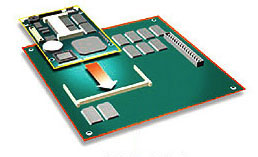 Embedded systems design is very different from designing consumer or even vertical market computing products. The life cycles of these systems is much longer than the rapid-fire change in consumer products, often five to seven years. Once a design problem has been solved, there is no need to reinvent the wheel, but there is a need to keep up with new processor, interface and peripheral technologies. As a result, embedded systems often include two components. They consist of what's called a "solution" or "carrier" board that then accommodates a small System-On-Module (SOM) board that includes the CPU, chipset, memory and other core functionality. Embedded systems design is very different from designing consumer or even vertical market computing products. The life cycles of these systems is much longer than the rapid-fire change in consumer products, often five to seven years. Once a design problem has been solved, there is no need to reinvent the wheel, but there is a need to keep up with new processor, interface and peripheral technologies. As a result, embedded systems often include two components. They consist of what's called a "solution" or "carrier" board that then accommodates a small System-On-Module (SOM) board that includes the CPU, chipset, memory and other core functionality.
There is a good variety of different computer-on-module standards, each addressing/emphasizing different technologies and priorities. One of the most recent ones is COM-Express, introduced in 2005 by the PCI Industrial Computer Manufacturers Group (PICMG). COM-Express is based on serial differential signaling technology for high performance embedded computing that requires maximum I/O bandwidth, such as medical imaging, industrial automation, mapping, security, aerospace, etc. COM-Express modules measure 4.92 x 3.74 inches (125 x 95 mm), but there is also a compact (95 x 95 mm), a mini (84 x 55 mm), and an extended 6.1 x 4.3 inch (155 x 110 mm) form factor, offering additional design and features flexibility.
The Advantech SOM-6765 COM-Express Type 2 Compact module
In this article, we're looking at a recent example of an Intel Atom-powered COM-Express module using the very compact 3.74 x 3.74 inch (95 x 95 mm) board footprint, the Advantech SOM-6765. We're also taking the opportunity to compare the new module with an older Advantech Atom-based module, the SOM-6760 that we reviewed a couple of years ago.
The picture below shows the SOM-6765 module from the bottom (left) and from the top (right). The bottom view shows the module's dual 220-pin board-to-board interface strips. The top view shows the sole connection (for a single memory module), and also the Intel Atom processor and associated chipset.

The SOM-6765 is a Intel Atom-based COM-Micro CPU module that can be ordered either with a 1.6GHz Intel Atom N2600 or a 2.13GHz Atom D2700 processor, both using the Intel "Tiger Point" NM10 Express system chipset. Both of chips are part of Intel's "Cedarview" family of Atom processors, introduced towards the end of 2011. Both are dual-core designs with four threads. There is a major difference, though: the N2600 is an ultra-frugal design with a design power of just 3.5 watts whereas the D2700 runs at 0.9 to 1.1 Volts and has a TDP of 10 watts.
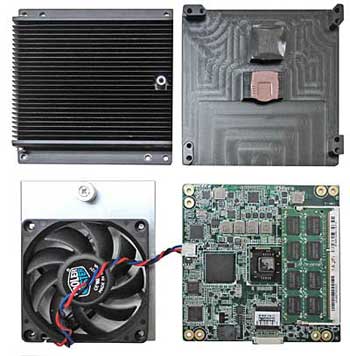 Even though the 10 watt TDP of our review board's Atom D2700 processor isn't much, Advantech went all out to make sure there won't ever be any thermal issues that could cause the board to fail. There is a meticulously milled metal heat spreader plate removing heat from the NM10 chipset (17 x 17 mm package size) and the D2700 processor itself (22 x 22 mm). The heat spreader is then mated to an equally hefty finned passive heat sink, and on top of that is a fan. No way will this setup ever overheat or even get hot. Even though the 10 watt TDP of our review board's Atom D2700 processor isn't much, Advantech went all out to make sure there won't ever be any thermal issues that could cause the board to fail. There is a meticulously milled metal heat spreader plate removing heat from the NM10 chipset (17 x 17 mm package size) and the D2700 processor itself (22 x 22 mm). The heat spreader is then mated to an equally hefty finned passive heat sink, and on top of that is a fan. No way will this setup ever overheat or even get hot.
The board has a single 204-pin SODIMM slot that can accommodate up to 4GB of 1066MHz DDR3 RAM (up to 2GB of DDR3 800 MHz for boards with the N2600 chip). While COM-Express boards may have interface card slots, the SOM-6765 doesn't have one.
Connection to the motherboard is via a special connector pair common to all COM-Express modules. The connectors have a total of 440 pins in four rows (A-D). The pins are combined into two strips of 220 pins each, X1 and X2, and are used for all communication between the SOM module and the carrier board. Row AB has pins for PCIexpress, SATA, LVDS LCD channel, LPC bus, video and TV-out, LAN, system and power management, and power/ground. ROW CD has pins for SDVO, legacy PCI and IDE signals, as well as additional PCI Express, LAN and power and ground pins.
In summary, the SOM-6765 board has the following features:
- It can be ordered with either a 1.6GHz Intel Atom N2600 or a 2.13GHz Intel Atom D2700
- Low to very low Thermal Design Power (3.5 or 10 watts)
- Intel NM10 chipset with 2.1 watt TDP
- Supports 8 USB 2.0, 8-bit GPIO
- Supports 2 SATA2 and one EIDE
- Intel 10/100/1000 Mbps LAN
- Intel Gfx graphics integrated in processor
- Graphics support: DX9, OGL 3.0, H.264; MPEG2, VC1, and MPEG4 hardware decoding
- Dual display support (CRT, DVI, LVDS), and video up to 1920 x 1200 pixel
The SOM-DB5700
COM-Express modules are always used in conjunction with a carrier board, and so it's appropriate to also see what carrier boards look like. The SOM-DB5700 our review CPU module was installed in is an ATX form factor COM-Express development board that complies with the COM Express standard from the PCI Industrial Computer Manufacturers Group. It looks just like a standard ATX motherboard except for the sockets designed to accommodate a COM-Express or COM-Micro board.
Our test setup consisted of a SOM-DB5700 development board (shown below), a full-size power supply, a SOM-6765 CPU board (shown mounted on the DB5700), a 22-inch HP LCD, and Windows 7 on a 250GB Seagate Barracuda 7200.12 SATA hard disk.
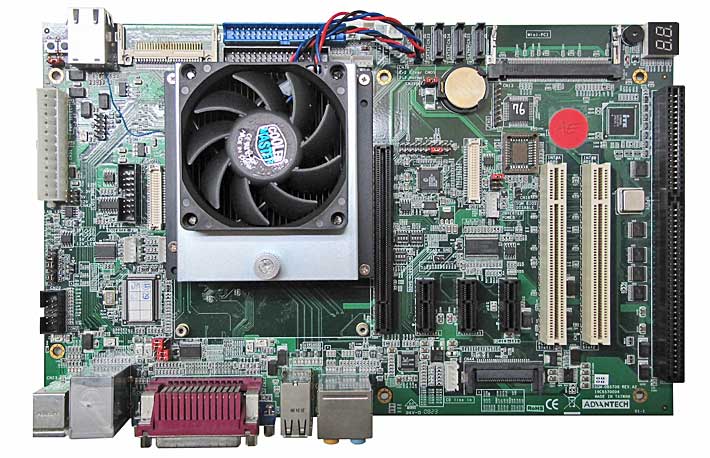
The 12 x 7.5-inch development board essentially offers a standard PC environment with PCI Express/PCI/ISA expansion interfaces and the following features and connectors:
- Accommodates any COM-Micro or COM-Express board
- 2 PCI slots
- 3 PCIe x1 slots
- 1 PCIe x16 slot
- 1 ISA slot
- 1 Express Card socket
- 1 CF Card socket
- 1 or 2 LVDS
- 1 standard VGA
- 1 TV-out
- 4 SATA Type B
- 1 EIDE
- 1 FDD
- 1 RS232, 1 RS232/422/485
- 1 LPT Parallel
- 2 PS/2
- 8 USB 2.0
The DB5700 development board is obviously a very flexible platform that covers a wide variety of interface, expansion and video technologies. In addition to the Atom "Cedarview"-based board we tested, Advantech also offers COM-Express CPU modules with various other Atom processors, as well as AMD and Intel Core i3/i5/i7 processors.
Comparison between the SOM-6765 and an older Atom Z530-based COM-Express module (SOM-6760)
While Intel's Atom processors have been quite successful with tens of millions used in netbook computers, early versions were a bit on the wimpy side. That was most likely because Intel initially positioned the platform as a competitor in the low-power arena, designed to do battle with ARM-based chips. There was probably also concern that the inexpensive Atom processors shouldn't be too powerful so as not to cannibalize Intel Core processor sales. The processor landscape has changed since then with Core i3/i5/i7 CPUs moving upscale, making room for a wider range of Atom processors.
To provide an idea where the current SOM-6765 stands in terms of performance compared to the Atom Z530-based SOM-6760 of a couple of years ago, we used the PassMark and CrystalMark 2004R3 benchmark suites. Here are the results (higher always better):
|
BENCHMARK PERFORMANCE
|
SOM-6765 (Atom D2700)
|
SOM-6760 (Atom Z530)
|
|
CPU Mark
|
631.9
|
315.6
|
|
2D Graphics Mark
|
48.0
|
207.2
|
|
Memory Mark
|
292.6
|
191.6
|
|
Disk Mark
|
849.7
|
70.6
|
|
3D Graphics Mark
|
95.2
|
19.6
|
|
Overall PassMark 7.0
|
411.4
|
137.3
|
|
CM 2004R3: CPU Alu
|
14,235
|
5,376
|
|
CM 2004R3: CPU FPU
|
10.567
|
4,667
|
|
CM 2004R3: Memory
|
8,842
|
3,667
|
|
CM 2004R3: HDD
|
13,383
|
2,702
|
|
CM 2004R3: GDI
|
2,157
|
2,427
|
|
CM 2004R3: D2D (Sprites)
|
824
|
1,009
|
|
CM 2004R3: OGL
|
9.632
|
505
|
|
Overall CrystalMark 2004R2
|
59,640
|
20,353
|
|
Playback 1280x720 HD movie in QuickTime
|
flawless
|
4-5 frames per second (choppy)
|
The results are somewhat confusing as it's virtually impossible to compare different processor families and architectures without running into weird looking numbers. That's the case here as well, especially in the PassMark benchmark. In our experience, though, the bottom line performance numbers of each benchmark generally provide a very good idea of the overall performance of a system. And here both benchmarks agreed: the Atom D2700-based SOM-6765 is vastly more powerful than the Atom Z530-based older SOM-6760.
Video playback performance used to be a particularly weak point of early Atom-based systems, and so we also some tests with high-def (720P) video. Here agin we saw a large generation gap. The SOM-6765 had no problem running 720p video smoothly and at full speed whereas the older board only managed to display a few frames every second.
So where does the SOM-6765 COM-Express board fit into the overall performance scheme of things? The answer is at roughly the level of older Core 2 Duo systems, such as the 1.6GHz L7500 or 1.4GHz SU9400. That's more than respectable. Designers who have stayed away from earlier Atom-based boards for performance reasons should revisit Atom-based solutions as they can now provide cost-effective platforms with much higher performance levels than only a year or two ago.
Below is a schematic of the Atom D2700-based Advantech SOM-6765 module:
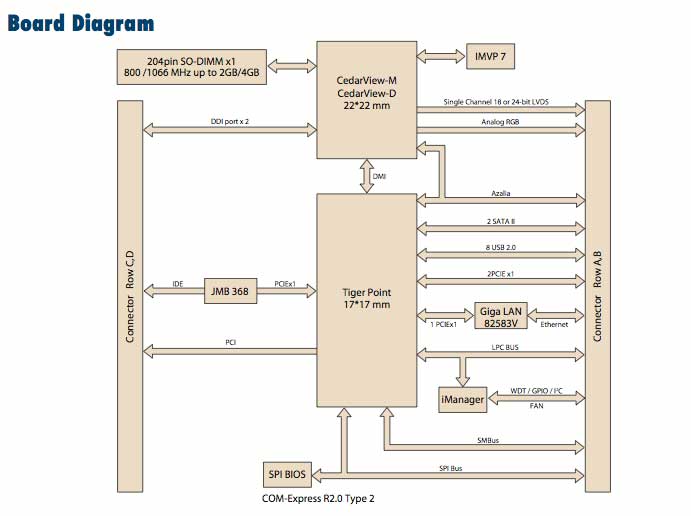
The side-by-side specifications below include data from both Advantech and Intel sources available online.
|
Advantech Atom-based COM-Express CPU modules specifications
|
| PRODUCT |
OLD: SOM-6760 (Atom Z530) |
NEW: SOM-6765 (Atom D2700) |
| Type |
COM-Micro CPU module |
COM-Express Type 2 Compact CPU module |
| Processor |
Intel Atom Z530 |
Intel Atom D2700 |
| Processor codename |
"Silverthorne" |
"CedarView" |
| Clock Speed |
1.60GHz |
2.13GHz |
| CPU Thermal Design Power |
2.0 watts |
10.0 watts |
| CPU package size |
13mm x 14mm |
22mm x 22mm |
| L2 cache |
512 KB |
1024 KB |
| CPU transistors |
47 million |
unknown |
| CPU cores |
1 |
2 |
| Intel Virtualization Technology |
Yes |
No |
| Intel Hyperthreading Technology |
Yes |
Yes |
| Enhanced Intel Speedstep |
Yes |
No |
| Intel Demand Based Switching |
Yes |
No |
| HD Audio Technology |
No |
Yes |
| Intel 64 |
No |
Yes |
| Front Side Bus |
533MHz |
2.5 GT/s |
| BIOS |
AWARD 4 MBit Flash |
AMI 16 MBit Flash |
| Chipset |
Intel System Controller Hub US15W |
Intel NM10 |
| Chipset size |
22mm x 22mm |
17mm x 17mm |
| Chipset TDP |
2.3 watts |
2.1 watts
| Chipset code name |
"Poulsbo" |
"Tiger Point" |
| Chipset tech documents |
see here |
see here |
| Memory |
up to 2GB DDR2 400/533MHz in one 200-pin SODIMM |
up to 4GB DDR3 800/1066MHz in one 204-pin SODIMM |
| VRAM |
Shared system memory up to 256MB |
unknown |
| Graphics Engine |
Intel GMA 500; DirectX 9Ex; supports H.264, MPEG2/4 hardware decoder |
Intel Gfx integrated |
| LCD |
24-bit single channel LVDS |
18/24-bit LVDS |
| VGA |
Up to 1600 x 1200 |
Up to 1920 x 1200 |
| Dual display |
CRT + LCD |
CRT + LVDS, CRT + DVI, LVDS + DVI |
| Ethernet |
Intel 8255 10/100 |
Intel 82583 10/100/1000 |
| Watchdog Timer |
256 timer intervals from 0 to 255 sec or min, set up via software |
65636 timer intervals from 0 to 65535 sec, mulit-level, multi-option |
| PATA |
1 EIDE (UDMA 100) |
1 EIDE (UDMA 100) |
| SATA |
none |
2 x SATA 2 (up to 300 MB/s) |
| USB |
8 x USB 2.0 |
8 x USB 2.0 |
| GPIO |
8-bit GPIO |
8-bit GPIO |
| Expansion |
LPC, 1 PCIe, 3 PCI master |
LPC, 2 PCIe, 4 PCI master, SMBus, I2C Bus |
| Expansion slots |
1 SD Card |
?? |
| Audio |
High definition audio interface |
Intel HD Audio |
| Power Consumption |
Typical: 5.7 watts; Max: 10.8 |
Typical: 67.6 watts; Max: 10.3 |
| Operating temp |
32° - 140°F |
32° - 140°F |
| Dimensions |
3.74 x 3.74 inches (95 x 95 mm) |
3.74 x 3.74 inches (95 x 95 mm) |
| Product brochure |
SOM-6760 |
SOM-6765 |
|
Advantech Corporation
38 Tesla, Suite 100
Irvine, CA 92618
Toll Free: 1-800-866-6008
Ph: 949-789-7178
Fax: 949-789-7179
ECGInfo@advantech.com
www.advantech.com
Advantech Co. Ltd.
No.1, Alley 20, Lane 26, Rueiguang Road
Neihu District, Taipei Taiwan 114, R.O.C.
Tel: 886-2-2792-7818
Fax: 886-2-2794-7301
www.advantech.com
|
|



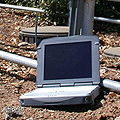

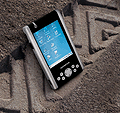
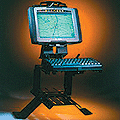





 Embedded systems design is very different from designing consumer or even vertical market computing products. The life cycles of these systems is much longer than the rapid-fire change in consumer products, often five to seven years. Once a design problem has been solved, there is no need to reinvent the wheel, but there is a need to keep up with new processor, interface and peripheral technologies. As a result, embedded systems often include two components. They consist of what's called a "solution" or "carrier" board that then accommodates a small System-On-Module (SOM) board that includes the CPU, chipset, memory and other core functionality.
Embedded systems design is very different from designing consumer or even vertical market computing products. The life cycles of these systems is much longer than the rapid-fire change in consumer products, often five to seven years. Once a design problem has been solved, there is no need to reinvent the wheel, but there is a need to keep up with new processor, interface and peripheral technologies. As a result, embedded systems often include two components. They consist of what's called a "solution" or "carrier" board that then accommodates a small System-On-Module (SOM) board that includes the CPU, chipset, memory and other core functionality.

 Even though the 10 watt TDP of our review board's Atom D2700 processor isn't much, Advantech went all out to make sure there won't ever be any thermal issues that could cause the board to fail. There is a meticulously milled metal heat spreader plate removing heat from the NM10 chipset (17 x 17 mm package size) and the D2700 processor itself (22 x 22 mm). The heat spreader is then mated to an equally hefty finned passive heat sink, and on top of that is a fan. No way will this setup ever overheat or even get hot.
Even though the 10 watt TDP of our review board's Atom D2700 processor isn't much, Advantech went all out to make sure there won't ever be any thermal issues that could cause the board to fail. There is a meticulously milled metal heat spreader plate removing heat from the NM10 chipset (17 x 17 mm package size) and the D2700 processor itself (22 x 22 mm). The heat spreader is then mated to an equally hefty finned passive heat sink, and on top of that is a fan. No way will this setup ever overheat or even get hot.

